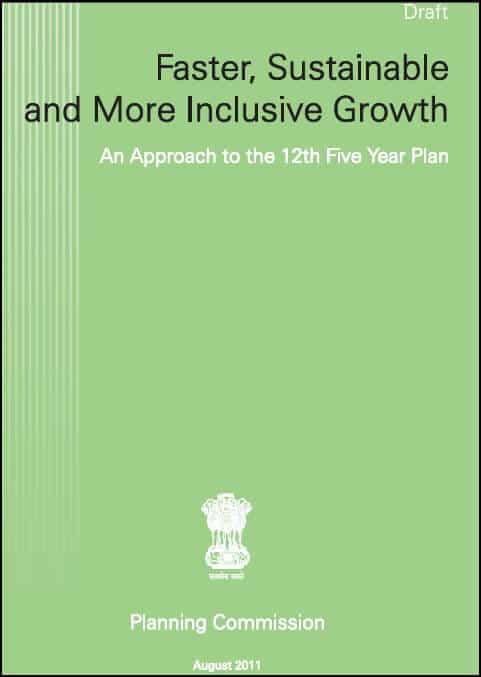Public Feedback and Discussion on Approach to 12th Five Year Plan The Twelfth Five Year Plan will commence in the Financial year 2012-13. However before the final Plan is unveiled, the Planning Commission normally prepares an Approach Paper which presents a broad outline, major targets, and the key challenges in meeting them. To develop an inclusive and participative approach to this process, the Planning Commission has decided that the Approach Paper will be evolved this time through a web-based consultative process in which all interested persons can participate. You can participate in the discussions about India’s 12th Five-year plan on the exclusive forum set up for the purpose at 12thplan.gov.in. You can also send your feedback by email to approach-plan(at the rate ) nic (dot) in. The draft Approach of India’s 12th Five Year Plan can be downloaded below:
12TH FIVE YEAR PLAN INDIA
Download the draft approach at the link below : 12th Five-year plan India – Draft approach – PDF 224 pages-2.5-MB Alternative download link: https://moneymint.com/12th_Five_year_plan-Vol-3.pdf Planning Commission 12th Five Year Plan Period – 2012 -2017 Based on an intensive process within the Planning Commission, the following ” Twelve Strategy Challenges ” have been identified to initiate the consultations. The “strategy challenges” refer to some core areas that require new approaches to produce the desired results.
Enhancing the Capacity for Growth Today, India can sustain a GDP growth of 8 percent a year. Increasing this to 9 or 10 percent will need more mobilization of investment resources; better allocation of these resources through more efficient capital markets; higher investment in infrastructure through both public and PPP routes; and more efficient use of public resources.
Enhancing Skills and Faster Generation of Employment It is believed that India’s economic growth is not generating enough jobs or livelihood opportunities. At the same time, many sectors face manpower shortages. To address both, we need to improve our education and training systems; create efficient and accessible labor markets for all skill categories, and encourage the faster growth of small and micro-enterprises.
Managing the Environment Environmental and ecological degradation has serious global and local implications, especially for the most vulnerable citizens of our country. How can we encourage responsible behavior, without compromising on our developmental needs?
Markets for Efficiency and Inclusion Open, integrated, and well-regulated markets for land, labor, and capital and for goods and services are essential for growth, inclusion, and sustainability. We have many sectors were markets are non-existent or incomplete, especially those which are dominated by public provisioning. How do we create or improve markets in all sectors?
Decentralization, Empowerment, and Information Greater and more informed participation of all citizens in decision-making, enforcing accountability, exercising their rights and entitlements; and determining the course of their lives is central to faster growth, inclusion, and sustainability. How can we best promote the capabilities of all Indians, especially the most disadvantaged, to achieve this end?
Technology and Innovation Technological and organizational innovation is the key to higher productivity and competitiveness. How can we encourage and incentivize innovation and their diffusion in academia and government as well as in enterprises of all sizes?
Securing the Energy Future for India Faster and more inclusive growth will require a rapid increase in energy consumption. Since we have limited domestic resources, how can we meet this need equitably and affordably without compromising on our environment?
Accelerated Development of Transport Infrastructure Our inadequate transport infrastructure results in lower efficiency and productivity; higher transaction costs; and insufficient access to our large national market. How can we create an efficient and widespread multi-modal transport network.
Rural Transformation and Sustained Growth of Agriculture Rural India suffers from poor infrastructure and inadequate amenities. Low agricultural growth perpetuates food and nutritional insecurities, which also reduces rural incomes. How can we encourage and support our villages in improving their living and livelihood conditions in innovative ways?
Managing Urbanization Most of our metros and cities are under severe stress with inadequate social and physical infrastructure coupled with worsening pollution. Migration pressures are likely to increase. How do we make our cities more liveable? What can we do today to ensure that smaller cities and towns are not similarly overwhelmed tomorrow?
Improved Access to Quality Education Educational and training facilities have been increasing rapidly. However, access, affordability, and quality remain serious concerns. Employability is also an issue. How can we improve the quality and the utility of our education, while ensuring equity and affordability?
Better Preventive and Curative Health Care India’s health indicators are not improving as fast as other socio-economic indicators. Good healthcare is perceived to be either unavailable or unaffordable. How can we improve healthcare conditions, both curative and preventive, especially relating to women and children?


